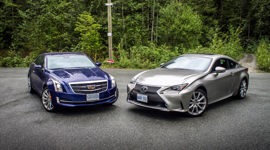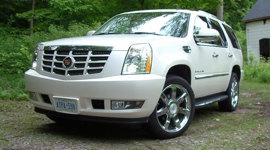Vehicle Type
Luxury compact sedan / coupe
Handling is top-notch, ride quality on most models is highly rated, and the car is said to offer a solid, dense and substantial feel.
History / Description
As a used entry-level luxury sports model, the Cadillac ATS is proving to be a compelling buy. Launched in 2012, Cadillac’s 3 Series fighter packed four- or six-cylinder power, manual or automatic transmissions, rear- or all-wheel drive, and nothing short of the market’s very latest in connected-car technology, safety and convenience content. Noted by reviewers and owners for pleasing handling, a comfortable ride, and fuel efficient performance – especially with the four-cylinder turbo engine – the ATS has moved plenty of units in just a few years on sale.
Launched originally as a four-door sedan to challenge competitors from BMW, Audi, Lexus and others; the ATS range expanded to offer a two-door coupe model for 2015. Both sedan and coupe variants offered plenty of selection, and a finely-honed range of options and packages that provide enhanced entertainment functionality, safety, convenience and performance.
Look for feature content including OnStar, Bluetooth, premium Bose audio, push-button start, navigation, memory seating, Magnetic Ride Control suspension, a pre-collision prep system, Blind Spot Monitoring, (excellent) adaptive xenon headlights, a heads-up display, remote start, and much more. Note that it should be easy to find an ATS that’s still covered by factory warranty, for added confidence.
Engines / Trim
Engine choices included a 2.5L four-cylinder engine, tuned for efficiency, and offering 202 horsepower. An available turbocharged 2.0L four-cylinder offered 270 horsepower, with available torque output approaching 300 lb-ft in newer models. The range-topping engine was the 3.6L V6, with 321 hp. Arguably, the four-cylinder turbo engine is the way to go. With more available torque than the V6 and highly comparable acceleration figures, the four-cylinder is easier on fuel, easier to maintain, and sees less weight over the front axle, which helps the ATS feel sharper and more lively.
Select rear-drive models could be paired with a six-speed stick, and all-wheel drive was available as well. Further, a performance package, with upgraded cooling, FE3 Sport suspension, wheels and brakes, was available.
What Owners Like
When it comes to handling, agility and responsiveness, the ATS seems to have impressed the majority of its owners, many of whom report the feel of the ATS as its best asset. Handling is top-notch, ride quality on most models is highly rated, and the car is said to offer a solid, dense and substantial feel. A quiet ride and a comfortable cabin round out the package, and the hidden storage compartment behind the central control panel is an oft-praised touch. ATS’s fast-acting and highly effective all-wheel-drive system is also favoured by owners who have that option, and your correspondent's test drive notes, on two separate occasions, mention excellent performance from the available xenon lighting system.
What Owners Dislike
Gripes often centre around limited rear-seat space, especially in two-door models. The CUE infotainment system is highly controversial: some owners love it, while many do not, saying that it’s hard to use, fussy, and slow-to-respond. Other complaints include the low-budget instrument cluster, and an overly sensitive front passenger seat occupant sensor, which sounds the ‘buckle up’ chime even if you’ve left just your cellphone or wallet on it. Finally, the V6 engine fails to impress most owners with its real-life fuel mileage.
Here’s a look at some owner reviews.
The Test Drive
Many owners have complained about the ATS’s run-flat tires, which seem to degrade ride quality on rough surfaces, and are unduly delicate and likely to suffer sidewall damage, which results in bulges. Inspect the inner and outer sidewall surfaces of each tire, by running your hand over the circumference, for signs of cracks, bubbles or lumps. If any are detected, the tire should be replaced for maximum safety. Here’s some more reading on this well-documented issue.
Turn off the radio and climate control system in the ATS you’re considering (once you’ve confirmed they work properly), and listen for unwelcome rubbing or grinding sounds at the rear of the vehicle – while stopping, steering, accelerating and cruising. The likely causes, if any such noise is detected, are either a sticky or improperly-aligned brake caliper, or a parking brake cable that’s routed too closely to the rear suspension and rubbing against its retainer bracket. Both issues are relatively easy to address, and here’s some more reading.
A note on the ATS’s engines: with direct injection and turbocharging (or both) present across the model range, it’s vital to adhere to factory-specified fluids, fuels and maintenance requirements. For instance, religious use of a top-tier grade of gasoline is vital to slow or eliminate the build-up of valve gunk typical of direct injection engines, so confirm that the seller always filled their ATS with premium gasoline. Strict adherence to spark-plug service intervals is also extra-important on this type of engine, which has a very precisely calibrated combustion process. Old spark-plugs can cause damage to ignition coil packs, and other issues. Finally, ensure oil changes have been performed at or before recommended intervals, and especially on the turbocharged engine.
If you’re unclear on the maintenance, fluid change or fuel requirements of the ATS you’re considering, check with your local dealer, or the owner’s manual.
Check the quality of the ATS’s idle, with the air conditioner both on and off. A tremble, or shuddering idle has been reported by a plethora of owners, ranging from intermittent and minor, to consistent and severe enough to nearly stall the engine. Though the cause and fix of this issue are not definite, some owners have had success in eliminating the rough idle through updated engine management software from their dealer.
Have a mechanic check the rear differential and axle seals for signs of leakage. Apparently, Cadillac issued a Technical Service Bulletin to help their dealer mechanics address this potential issue. A leaking axle seal or differential can easily go undetected, and may cause accelerated component wear. Here’s some more reading. A mechanic should also check the front engine cover for signs of oil leakage. This is reported rarely, but worth a mention.
Run the CUE system through its paces, flicking through all menus and functions, programming a destination into the navigation system, making a call via Bluetooth, and the like. If the system hangs, crashes or lags, or otherwise performs unusually, a hard reset or software update (relatively easy and low-cost, or free) may solve the issue. If not, new system hardware may be required. Some owners have had associated components replaced under warranty. If the ATS you’re considering is nearing the end of its warranty, be sure to have a dealer service advisor document any issues for easier warranty claims. Here’s some more information. Note that some owners have also reported display screens that crack or spiderweb from the inside, so be on the lookout. If you notice any such damage, check to see if it’s covered by warranty. If not, have the seller knock a good chunk off of the purchase price, or move to another unit.
The Verdict
The ATS’s most common issues should be easy to spot on a test drive, or via a pre-purchase inspection by a Cadillac technician. If the model you’re considering checks out as healthy, you’re on your way to owning a sporty compact luxury car loved for world-class handling and luxury. Opt for a low-mileage, in-warranty unit where your budget allows, for maximum peace of mind.
A list of recalls.
Crash Test Scores
NHTSA: 5/5 Stars (all years, sedan only)

















































